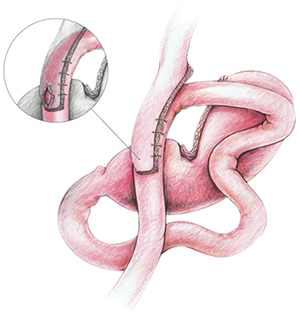Lap Single anastomoses Bypass or
Mini-Gastric Bypass
The mini-gastric bypass procedure has gained popularity in recent years. The mini-gastric bypass was originally developed by Dr. Robert Rutledge in 1997. The mini-gastric bypass is quicker, technically easier and carries a lower complication rate compared to traditional gastric bypass surgery, 2.9% (2012 MGB study).
The mini-gastric bypass procedure is restrictive and malabsorptive. This means that the procedure reduces the size of your stomach, restricting the amount you can eat. The procedure also reduces absorption of food by bypassing up to 6 feet (200cm) of intestines. Gastric bypass and the mini-gastric bypass are both malabsorptive and restrictive procedures, while the Lap Gastric sleeve and the Lap Band are mainly restrictive procedures.
WHY WAS THE MINI-GASTRIC BYPASS CREATED?
The mini-gastric bypass was developed to reduce operating time, simplify the procedure and reduce complications. Recent studies show that it does reduce operating time, may lead to similar weight loss (some studies show that mini-gastric bypass may actually produce more weight loss), and reduce overall complication rates compared to gastric bypass surgery



